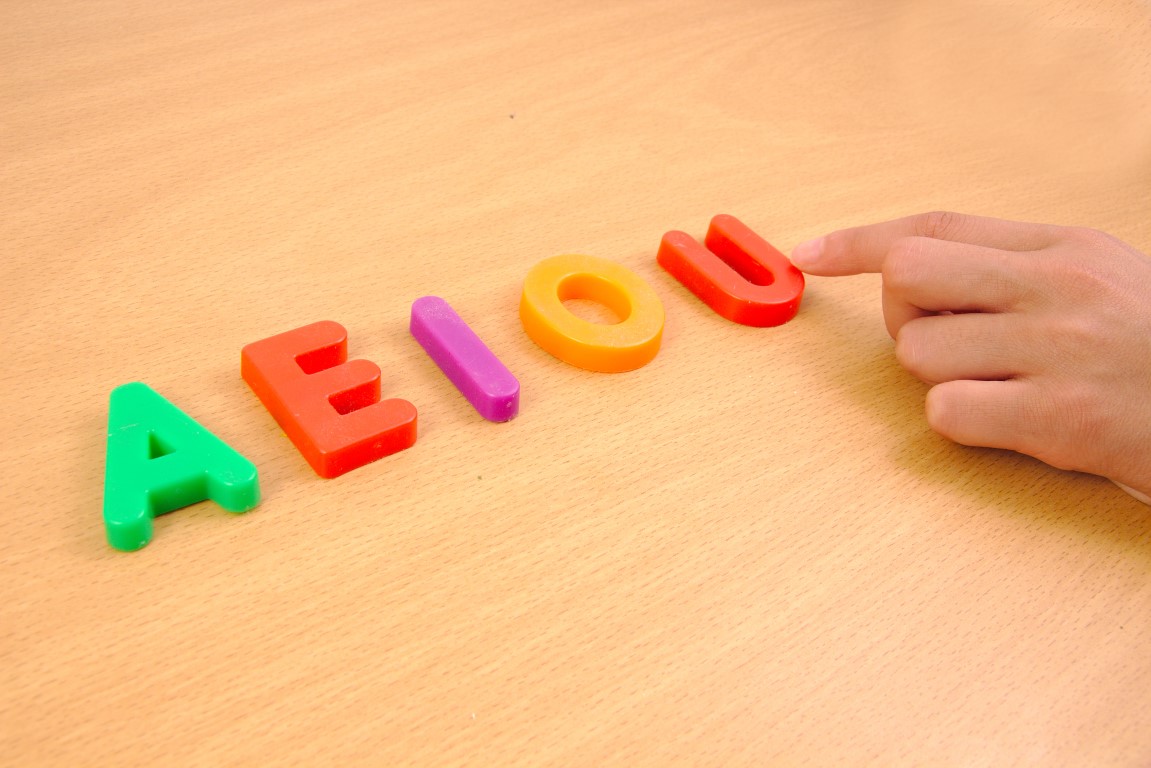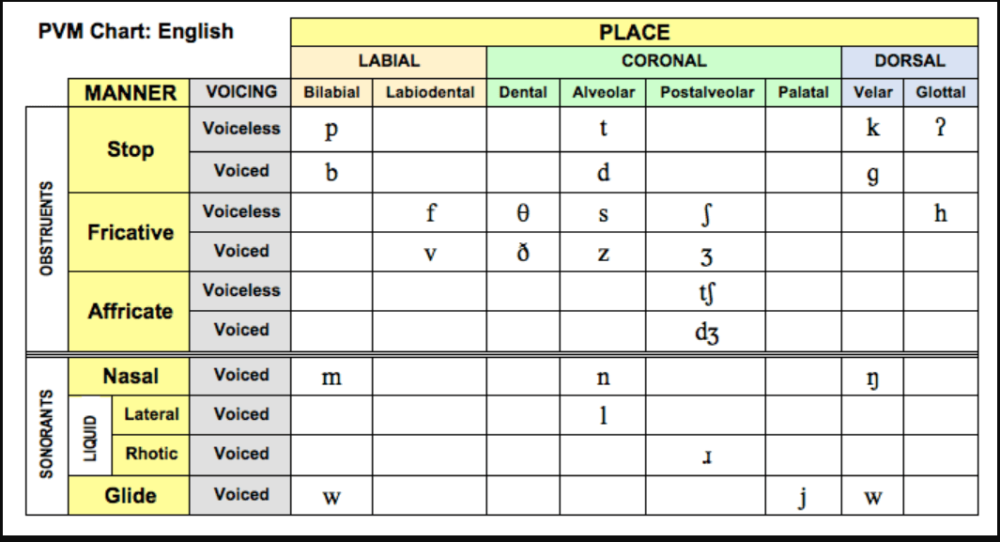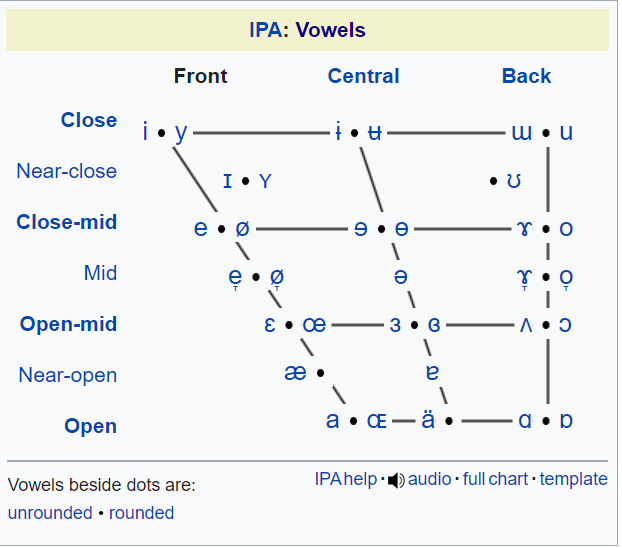Vowels and consonants make up the alphabet.
What are the vowels and consonants in the Latin alphabet?
There are 26 letters in the letters of the alphabet. They are usually divided into 5 vowels and 21 consonants.
The Differences between the Vowels and the Consonants
Consonants and vowels make up the syllables in a word.
Vowels and consonants have different sounds.
Vowel sounds are made with our mouth and throat open, while consonants are made by blocking air.
Vowels vary in terms of quality, loudness and in length. The vowels cause different variations, such as stress, tone and intonation.
The Vowels
In the English language, for example, there are only five vowels: A, E, O, I and U.
Y and W sometimes act as a vowel.
For example, ‘Y‘ at the beginning of words, like yellow, is a consonant, but ‘y’ at the end of the word is a vowel, like sunny and baby.
There are 20 vowel sounds in English.
We make vowel sounds by opening our mouth more and allowing the flow of air, without closing any parts of the throat or mouth.
When two vowels are put together to make a sound, we call it a vowel digraph. For example, read, boat, foot, moon. and rain.
Every English word contains a vowel. These can be pure vowels (short and long vowel sounds) or glide vowels (diphthongs).
| Short Vowel Sounds | Long Vowel Sounds | Diphtongs/ Glide Vowels |
| /e/ – went, intend, dead, bed | /Ɔ:/ – law, father, talk, all | /eɪ/ – space, rain,they |
| /Ɑ/ – top, off and cloth | /i:/ – each, see, be, city, people | /ɪə/ – beer, ear, near |
| /Ə/ – us, even, the, just, other | /Ɛ:/ – bed, best, get, friend | /ʊə/ – poor, during, security |
| /Ɪ/ – it, give, enough, become | /u:/ – who, food, you, through | /ɔɪ/ – noise, joy, employ |
| /Ʊ/ – push, up, took | /ɑ:/ – car, are, hard, bath | /eə/ – hair, pear, there |
| /ʌ/ – cup, money, fun, London | /aɪ/ – my, flight, dice | |
| /Æ/ – mat, have, sad | /əʊ/ – no, vote, don’t, go | |
| /aʊ/ – out, cow, mouth | ||
The Consonants
The 21 consonants are b, c, d, f, g, h, j, k, l, m, n, p, q, r, s, t, v, w, x, y, z.
There are 24 consonant sounds.
We make consonant sounds by blocking air flow in some kind of way using our tongue, lips, teeth or the roof of our mouth.
Voiced Consonants: voiced sounds are produced with the vocal cords, for example, B, D, G, J, L, M, N, Ng, R, Sz, Th.
Unvoiced or Voiceless Consonants: whispery sound without pitch, for example, Ch, F, K, P, S, Sh, T, and Th.
When two consonants are put together to make a sound, we call it a consonant digraph. For example, nephew, chip. phone and bath.
Vowels and Consonants in Primary School
At the nursery and reception years, students learn the alphabet and their sounds.
They then move on to learn CVC words (consonant vowel consonant) words like tap, pat, nap and can.
Students will eventually progress to CVCC words (consonant vowel consonant consonant) such as sink, belt, cold.
Students will also learn how to read words with two vowels together to make a sound, such as book, rain, lie, read. When the two vowels combine to make a different sound it’s called a vowel digraph.
Students will also learn how to read words with two consonants to make a sound, such as thank, chart, sheep, shop. When the two vowels change to make a different sound it’s called a consonant digraph.
Types of Consonant Sounds
- Stop Consonants: airflow is stopped by the mouth and released, (p, b, t, d).
- Fricative Consonants: airflow has only a small space to travel, making it sound more noisy, ( f, v, s, z etc).
- Nasal Consonants: airflow passes through the noise instead of the mouth, (m, n, ).
- Affricate Consonants: begins like a stop consonant but ends with a fricative, (the ‘ch sound’ /ʧ/ and ‘j sound’ /ʤ/ ).
- Glide Consonants: similar to a vowel sound in which the air is stopped, but not as much as the fricitative or stop consonants, (w, j).
Places of Articulation
The place where the sounds are produced for consonants are as follows:
- Bilabial sounds: sounds made with two lips (p, b, m)
- Labia-dental sounds: sounds (f, v), made with the lower lips and upper front teeth
- Dental sounds: sounds produced with the tips of the tongue and upper front teeth contact ( l, t, d, and n)
- Alveolar sounds: sounds made by the touch of the tip of the tongue to the alveolar ridge (t, n and d)
- Palatal sounds: sounds made when the tongue’s blade strikes the hard palate (j)
- Velar sounds: requires the back of the tongue and soft palate to come into touch with each other (k, g, ŋ)
- Glottal sounds: the sound made in the larynx (h)
The International Phonetic Alphabet
It’s often very hard to predict the English pronunciation of words when reading new words.
It is useful to show the English language through a set of symbols called the international phonetic alphabet (IPA).
An international phonetic alphabet is a useful tool for learning vowels and consonants in any language. The benefit of using this is that it can be applied to many languages.
This can help you improve your pronunciation but doesn’t necessarily provide a fix for the various nuances and tonality in languages like Mandarin and Vietnamese.
You can find the full International Phonetic Alphabet Chart here.

You may also be interested in: 15 Best Online English Courses Free & Paid (2022)
International Phonetic Alphabet: Consonants Description
/P/
The /P/ sound is a voiceless bilabial stop.
It is usually represented as the letter p.
We make the sound by using both of our lips to block the mouth.
It is found in words like place, play, help and happy.
/B/
The /B/ sound is a voiced stop made by a quick puff of air forced through the mouth.
It is usually represented as the letter b.
It is found in words like boy, baby, bed and web.
/T/
The /T/ sound is an unvoiced stop made with the tip of the tongue on the alveolar ridge.
It is usually represented by the letter t.
It is found in words like toy, late, top and sting.
/D/
The /D/ sound is a voiced stop made by a quick puff of air forced through the mouth. Touch the tip of the tongue on the alveolar ridge to make this sound.
It is usually represented by the letter d.
It is found in words like sad, dad, do and made.
/K/
The /K/ sound is a voiceless stop made by blocking the airflow from the throat with the back of the throat.
It is usually represented by a number of different consonant letters, such as C, CC, K, CK, QU and sometimes CH.
It is found in words like can, kid, cat and chaos.
/G/
The /G/ sound is a voiced stop made by positioning the back of the tongue on the roof of the mouth.
It is usually represented by the letter g.
It is found in words like go, girl, get and big.
/F/
The /F/ sound is an unvoiced fricative made by placing the upper front teeth on the lips and blowing out.
It is represented by the letters f, ph and sometimes gh.
It is found in words like friend, laugh, stuff and phone.
/V/
The /V/ sound is a voiced fricative made by also placing your upper front teeth on your lips and blowing out.
It is represented by the letter “v” and rarely spelled with the letter “f.”
It is found in words like very, never and of.
/Θ/
This /Θ/ sound is an unvoiced fricative that is made by blowing air between the tip of the tongue and the top teeth. You have to stick your tongue out a bit to make this sound.
It is represented by the letters “th.”
It is found in the words three, something and month.
/Ð/
The /Ð/ sound is a voiced fricative that is made by blowing air between the tip of the tongue and the top teeth. You have to stick out your tongue to make this sound, just like the /Θ/ sound.
It is also represented by the letter cluster “th.”
It is found in words like this, that and other.
/S/
It is a voiceless fricative made by directing air with the tongue towards the edge of your teeth. Put your tongue near the alveolar ridge and blow out.
It is represented by the ‘s’ or sometimes ‘c’ letter.
It is found in words like see, once, sell and city.
/Z/
This is a voiced fricative made by directing air with the tongue towards the edge of your teeth. Put your tongue near the alveolar ridge and blow out.
It is represented by ‘z’ and sometimes ‘s’ and ‘th.’
It is found in words like as, his, rose and clothes.
/ʃ/
This is a voiceless fricative made by placing the tongue a little bit past the alveolar ridge. It is the sound we make when we ask for everyone to be quiet: “Shh!”
It is represented by the letters “sh,” “si” and “ti.”
It is found in words like she, sure, leash, national, information and should.
/Ʃ/
This is a voiced fricative that is made by placing the tongue a little bit past the alveolar ridge. It is the voiced counterpart of /ʃ/ .
It is represented by the letters “g,” “s,” “z,” “ti” and “si.”
It is found in words like “conclusion,” “vision,” “decision,” “visual” and “genre.
/TƩ/
This is a voiceless affricate made by touching the alveolar ridge with the tip of the tongue,
It is represented by the letters “ch” or sometimes “t.”
It is found in words like “China,” “teacher,” “chat” and “chair.”
/DƷ/
This is a voiced affricate made by touching the alveolar ridge with the tip of the tongue.
It is represented by the letters “j,” “g,” and “dj.”
It is found in words like “judge,” “ginger,” “suggest” and “adjust.”
/H/
This is a voiceless fricative which is made by constricting the throat and breathing out. The mouth does not take a particular shape.
It is represented by the letters “h” and “wh.”
It is found in words like “who,” “ham,” “behind” and “help.”
/ʔ/
This is known as a glottal stop. It is a voiceless fricative made by stopping the airflow through the glottis.
It is represented by the letters “t” or “-.”
It is found in words like “Manhattan,” “kitten” button, and “uh–oh.” This stop is more common in American accents. Most Americans don’t use a harsh “t” sound to pronounce “Manhattan” but use a /ʔ/ sound instead.
/M/
This is a voiced nasal sound made when the lips are shut. This sound is like a vowel sound but made in the nasal cavity.
It is represented by the letter “m,” “mn” and “mb.”
It is found in words like climb, movie, man and column.
/N/
This is a voiced nasal sound made by placing the tip of the tongue on the alveolar ridge.
It is represented by the letter “n,” “ne,” “kn,” and “gn.”
It is found in words like now, resign, knight and dinner.
/Ŋ/
This is a nasal sound made by touching the tongue against the back of the mouth so it blocks the throat.
It is represented by the letters “ng” and sometimes “nk.”
It is found in words like sing, something, drink and young.
The /Ŋ/ sound is not found in every “ng” word. For example, the word finger has the /g/ sound. If the word ends in ng, then it should be /Ŋ/ sound.
/ɾ/
This is an alveolar tap whereby the tip of the tongue lightly throws itself against the alveolar ridge.
It is usually represented by a “t” or “d.” It is more likely to be heard in American English.
It is found in words like water, better, party and odor.
The /ɾ/ sound is also pronounced as the letter “r” in many languages.
/X/
The /X/ sound is a voiceless fricative made by putting the back of your tongue near the soft palate.
It is usually represented by the letters “gh.”
This does not occur in English, except for the Scottish word “loch.” It can also be found occasionally in words like “ugh” to make it sound more exasperated.
International Phonetic Alphabet: Approximants Description
Approximants are sounds that lie somewhere between consonants and vowels. They are vowel-like consonants that occur as “glides” or “liquids.”
/L/
This liquid is made by keeping the tip of the tongue on the upper teeth.
It is represented by the letter “l.”
When it is followed by a vowel, it is called a “clear l,” for example, late, land, elegant.
Otherwise, it can be known as a “late l,” when it is followed by a consonant or a pause. It is found in words like full, milk, illness and bull.
/ɹ/
This is one of the more awkward English sounds and one of the least common “r” sounds in English.
The /ɹ/ is made by curling the tongue into itself, to the back of the mouth.
It is found in words like real, wrong, run and earnest.
The English sound is often written as /r/ for simplicity, but the actual symbol /r/ is a trill style R in Spanish and Italian, like in the Spanish word “perro.”
/J/
This is a voiced palatal approximate made by bringing your tongue close to the roof of your mouth and releasing it.
It is usually represented by the letter “y” or some vowels.
It can be found in words like year, view, beyond and billion.
It can also be heard in words with the letter “u,” like cute and pure.
International Phonetic Alphabet: Vowels Description
Vowels are moreso approximations in the IPA as vowels are often pronounced differently depending on the accent.
- Close vowel: produced if the mouth is more closed.
- Mid vowel: produced when the mouth is open slightly.
- Open vowel: occurs when the mouth is more open.
Here is a chart that shows the placement of the vowels on the IPA graph. For example, a close or high front vowel like the vowel /i/ is produced with a tongue elevation in the front of the mouth while the low back vowels like /ɑ/ is produced with the lowest tongue elevation with the tongue positioned in the back.
The vowel length is marked as long by adding a colon-like symbol to the word. For example, clean is written as [kliːn].
Here are some of the pure vowels:
/Æ/
This is a voiced sound created by putting your tongue low in your mouth and stretch your lips.
This is usually represented by the letter “a.”
It is found in words like mat, have, sad.
/Ɑ/
This is a voiced sound created by opening your mouth wide and flattening the tongue in the mouth. Your lips should be relaxed. The tip of your tongue should be touching the back of your lower front teeth.
This is usually represented by the letter “o” or “a.”
It is found in words like top, off and cloth.
/Ɔ/
/Ɔ/ is an open-mid back rounded vowel. Open your mouth wide as possible and round your lips. Flatten your tongue low in your mouth. The tip of your tongue should be touching the back of your teeth.
This is usually represented by letters such as “aw,” “a,” “au” and “al.”
It is found in words like law, father, talk and all.
This sound is less popular nowadays as more people with a general English American accent are starting to pronounce words like “cot” and “caught” with the /a/ sound, and disregarding the /Ɔ/ sound altogether.
/Ə/
This is known as the “schwa.” It is used for unstressed vowels. Place tongue in the middle and center of the mouth and make a short guttural noise to produce the sound.
It is often represented by the letters u, er and ou and even l. It is a very common sound and almost any vowel letter can make the “schwa” sound. It is used for unstressed vowels whereas stressed vowels with a similar sound are represented by the
It is found in words like us, even, the, just, people and other.
/Ɪ/
The /Ɪ/ sound can be made by placing the tongue close to the top and front of the mouth. The lips are stretched out as if you are smiling. It is similar to the “e” sound but shorter. Make the sound with your mouth slightly opened.
It is represented by the letter “i” and sometimes “e.”
It is found in words like it, give, enough, become and amiss.
/i:/
To make the /i/ sound, raise the tongue high and push it to the front of the mouth, lowered behind the bottom front teeth.
It is represented by the letters “ee,” “ea,”
It is found in words like each, see, be, city and people.
/Ɛ/
To make the /Ɛ/ sound, push the tongue to the front of the mouth with the tip of the tongue lowered behind the bottom front teeth.
This sound is represented by the letters “e” and “ea.”
It is found in words like bed, best, get and friend.
This sound is entirely replaced by the /e/ sound in Australian English and other accents.
/ɹ̩/ Or /ɚ/
These are represented by the letters “er,” “ear,” “eur,” “or,” “ur” and “ir.”
It is found in words like burn, earth, worm, winner, after and amateur.
The markings on these sounds indicate they can constitute their own syllable without any help from the vowels.
/Ɜ/
This is the open mid-central unrounded vowel. The tongue is low in the center of the mouth. It is a long sound.
This sound is represented by the letters “er,” “ear,” “ir,” “eur,” “ur,” and “or.”
This sound is found in words like person, word, turn, earth, worm and bird.
/Ʌ/
The /Ʌ/ sound is made when the tongue is low and in the middle and back of the mouth. Place the tongue low in the middle and back of the mouth. Make a short voiced sound with the mouth open.
It is found in words like but, up, another, other and come.
/Ʊ/
To make this sound, the front of the tongue stays down but pulled slightly pulled back so it is not quite touching the back of the front teeth.
This is similar to the “shwa” sound but it is usually reserved for stressed vowels.
It is represented by the letters “oo,” “u” and “oul.”
It is found in words like “push,” “up,” and “took.”
/U/
This is a close back rounded vowel. Put the tongue high, at the back of the mouth and lightly push the lips together while making a voiced sound.
It is represented by the letters “oo,” “u,” “ou,” “ugh,” “ew,”
This is found in the words like to, you, who, issue, through and threw.
This is usually used to represent the “u” in Spanish words like “luna” and “tu.”
/O/
To make this sound, pull the tongue back and tense it. The jaw should be partially lowered and the lips should be rounded and tensed, making a tighter circle.
This is found in words like go, foe, throw, soap and though.
This is usually used to represent the “o” in Spanish words like “hola” and “gato.”
In Conclusion
Vowels and consonants have different sounds.
We make vowel sounds by opening our mouth and allowing the flow of air, without closing any parts of the throat or mouth.
We make consonant sounds by blocking air flow in some kind of way using our tongue, lips, teeth or the roof of our mouth.
The IPA can help improve the pronunciation of the vowels and consonants.
Caitriona Maria is an education writer and founder of TPR Teaching, crafting inspiring pieces that promote the importance of developing new skills. For 7 years, she has been committed to providing students with the best learning opportunities possible, both domestically and abroad. Dedicated to unlocking students' potential, Caitriona has taught English in several countries and continues to explore new cultures through her travels.



